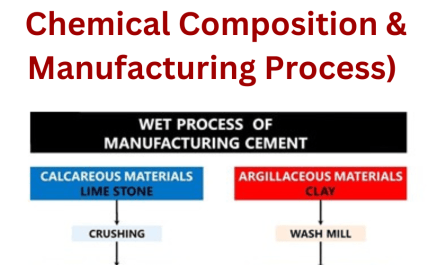RAPID HARDENING CEMENT
Definition:
Rapid Hardening Cement (RHC) is renowned for its ability to swiftly attain high strength during the initial stages of concrete curing, akin to its counterpart, Ordinary Portland Cement (OPC). Characterized by augmented lime content, elevated C3S content, and finer grinding, RHC outpaces OPC in early strength development.
Notably, the strength of Rapid Hardening Cement matches that of OPC at three days with the same water-cement ratio, equating to the seven-day strength of OPC. This attribute enables the early removal of formwork, expediting construction timelines and economizing costs by mitigating formwork expenses.
Rapid Hardening Cement finds application in diverse construction contexts, notably prefabricated concrete construction and road works. Tailored to furnish high early strength, RHC is particularly advantageous in scenarios necessitating swift setting and early load-bearing capacity. This accelerated strength gain is facilitated by strategic modifications to the composition and fineness of the cement clinker, underscoring its efficacy in expediting construction processes.

key features :
- High Early Strength: Rapid Hardening Cement (RHC) distinguishes itself with accelerated strength development in the initial days following water mixing. This characteristic facilitates expedited formwork removal and early loading of structures, thereby reducing construction duration.
- Fineness: RHC features clinker particles ground to a finer size, amplifying the surface area available for hydration. This heightened reactivity fosters rapid cement hydration and strength augmentation, bolstering the overall performance of the concrete.
- Setting Time: Rapid Hardening Cement typically boasts a shorter setting time compared to Ordinary Portland Cement (OPC). The onset of initial setting may transpire in mere minutes, while the final setting time remains within a reasonable timeframe conducive to construction operations.
- Applications: RHC finds applicability across a spectrum of construction endeavors, encompassing repair and rehabilitation work, precast concrete elements, cold weather concreting, and projects characterized by stringent construction schedules. It is particularly favored for emergency repairs necessitating prompt structural restoration.
- Curing: Despite its accelerated strength gain, proper curing practices are imperative for RHC to realize its full potential in terms of strength and durability. Adequate curing safeguards against premature drying and cracking, facilitating the development of enduring structural integrity.
- Limitations: While RHC offers the advantage of rapid strength development, it may not achieve the ultimate strength attained by OPC over the long term. Consequently, it may not be deemed suitable for construction projects prioritizing long-term strength and durability.
- Precautions: Owing to its rapid setting nature, prudent handling of RHC mandates meticulous planning and coordination. Careful consideration during transportation, placement, and finishing is essential to mitigate potential challenges. Effective workforce management and utilization of appropriate construction equipment are pivotal for ensuring seamless integration and optimal performance.



